By Lieutenant Commander Zeke Lyons, U.S. Coast Guard Academy, Hotel Company Officer and Sailor
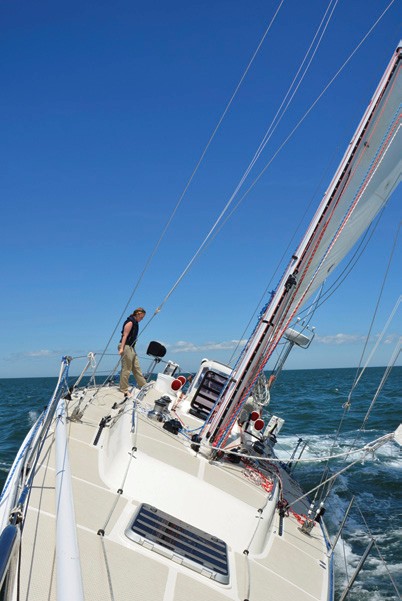 I have the best job in the world. For the last three summers from my homeport in New London, Connecticut, I have sailed with U.S. Coast Guard Academy cadets on a two-week sailing adventure where we cruise to some of the finest ports in New England on our fleet of 44-foot sailboats. On this trip, the cadets practice peer leadership, teamwork and of course, seamanship; but it’s so much more. It becomes an experience of life-changing self-discovery that leads to a liking for the sea and insights and life lessons that add meaning and purpose to their existence as future Coast Guard officers.
I have the best job in the world. For the last three summers from my homeport in New London, Connecticut, I have sailed with U.S. Coast Guard Academy cadets on a two-week sailing adventure where we cruise to some of the finest ports in New England on our fleet of 44-foot sailboats. On this trip, the cadets practice peer leadership, teamwork and of course, seamanship; but it’s so much more. It becomes an experience of life-changing self-discovery that leads to a liking for the sea and insights and life lessons that add meaning and purpose to their existence as future Coast Guard officers.
The cadets that sail are new second-class cadets who are halfway through their four years of academic classes, physical and moral development and professional military and seamanship training. They have spent the previous summer sailing on Eagle, our historic 295-foot tall ship. This halfway point marks what many of the cadets say is the highlight of their Academy experience – sailing on eight of the Academy’s new Pedrick-designed, Morris Yachts-built Leadership 44s through our Coastal Sail Training Program. In this program, cadets are divided into crews, usually six or seven per boat, and paired with a safety officer (the other luckiest Coast Guard officers in the fleet; all of whom are instructors at the Academy who teach everything from Physics to English Literature to Mechanical Engineering – plus one civilian sailing coach who leads the program). Four of the boats then sail together for two weeks, stopping in Block Island, Cuttyhunk, Martha’s Vineyard, Nantucket, Cape Cod, Woods Hole, Newport, and Stonington.
What works best about this trip is that the cadets have full responsibility for operation and navigation of the sailboat, and they thrive under such immersion and autonomy. Each day, the cadets rotate through the positions of engineer, deckhand, navigator, cook and watch captain, who is overall in charge. For perhaps the first time in their cadet careers, they really feel the burden of responsibility, and the peer leadership they practice is a bigger deal than they think. They make real-life decisions with regard to navigation, sailing evolutions, and docking. We even give them cash to go shopping for their meals, which they cook on board – some cooking for the first time.
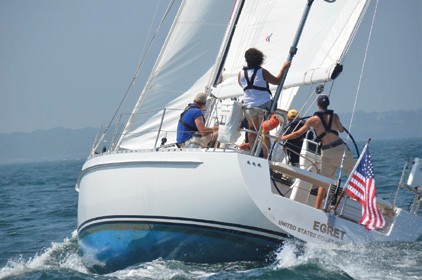 “I think the biggest challenge for me was leading my peers,” said Cadet Jasen Kingsley. “Our lives are so centered around a chain of command with superiors and subordinates, but on this trip we have to hold our peers, our friends, and our equals accountable. In such tight quarters, next to only five or six of our classmates, we must do this and find a way to do it successfully because if we don’t that sailboat is not going to go anywhere.” At the end of each day of sailing, we debrief and the cadets humbly
“I think the biggest challenge for me was leading my peers,” said Cadet Jasen Kingsley. “Our lives are so centered around a chain of command with superiors and subordinates, but on this trip we have to hold our peers, our friends, and our equals accountable. In such tight quarters, next to only five or six of our classmates, we must do this and find a way to do it successfully because if we don’t that sailboat is not going to go anywhere.” At the end of each day of sailing, we debrief and the cadets humbly
Egret is one of the U.S. Coast Guard Academy’s eight Leadership 44s. © LT Anderson Ogg
and openly reflect on each day’s lessons learned related to sailing, leadership, and followership. Because the experience of the day is so fresh and real, there is always plenty to talk about and commitments to make to change for the future – for example, tomorrow.
The secret is, though, that it’s not just about the sailing. We want the cadets to come away with a liking for the sea, a seaman’s eye, navigation and sailing skills – and they do. But it’s about the life and leadership lessons learned aboard that can be applied to the future. It’s about transferring what they learn while sailing toward living more abundantly in life, as leaders, in relationships and in organizational life. On this trip, there are choices and consequences, failures and conquests, the facing of dangers and plodding on in rigorous conditions; there is triumph and tragedy, all of which are strung together in an adventure story with a happy ending. On the boats, it’s an environment where mistakes are mutually inevitable, expected, celebrated and most importantly – learned from. Needless to say, it’s the ultimate teaching job. Kurt Hahn, the founder of Outward Bound, said it best when he wrote, “I regard it as the foremost task of education…to ensure the survival of these qualities: an enterprising curiosity, an un-defeatable spirit, tenacity in pursuit, readiness of sensible self-denial, and above all compassion.” Our job, as safety officers, is that we first teach them to sail, and then in two weeks we watch them grow up.
To do so, we take a break from emails, reports, papers, classes and finally get to really live! The most important thing each morning is not the traffic and news or how many meetings we have that day; rather, the most important thing is to know from which way the wind will blow and how strong it will be. Here are some of the other life and leadership lessons that we teach:
You can’t always get where you need to go by going directly there.
The cadets learn this one easily on our first upwind sailing day. As they try to beat into the wind they find that they have to tack back and forth to get there. Unlike a powerboat, sailboats can’t go straight to their destination. And this might be the enchantment of sailing. It’s about enjoying those zig-zags – taking the longer, more scenic route. It’s about zigging over here so we can zag back to make the mark. There are real consequences for zigging when we should have zagged, and sometimes a 90-degree zag becomes a 540-degree, Tony Hawk-style-skateboarding-roundabout (come on, you’ve all seen a tack become a jibe)! In life and in our careers, we’ve all likely experienced unplanned detours and unexpected zig-zags. Upon reflection, we can all probably be glad for the zigs and zags and other surprises that didn’t take us straight from here to there.
There were the doors that closed that allowed for others to open. Perhaps it was the road less traveled, as Robert Frost wrote, that made all the difference. My life has not gone according to a plan, and I’m glad it hasn’t because it has been better than the plan! What is the destination of life anyway? Is it about the journey or the destination? On this trip, we zig and zag to special places so that the cadets can truly appreciate that it is about both journey and destination. Just like life.
You have to say what you need in order to get what you want.
On a boat, and a sailboat in particular, the cadets learn a whole new language. They learn that you can’t just say, “Pull on that line over there.” They learn that they have to say, “Take the slack out of the portside jib sheet.” To really sail a boat is to fully utilize each unique piece and part appropriate to its capabilities. During the trip we talk about how true this is in our life and relationships. People, like sailboats, are complex. We talk about how we might have unmet expectations because they haven’t been expressed. In other words, we can’t get what we need because we haven’t asked for the specifics of what we want. The cadets reflect about whether anything in their relationships is left unsaid or generically glossed over and, as a result, never attained. Organizational and relational improvements come from facing facts and realities. Good feedback and learning requires specifics from teachers, coaches and those we trust.
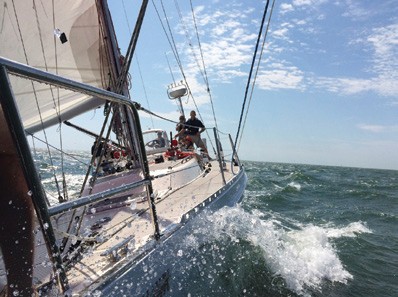 On every sailing trip with cadets, there is conflict. Many times, there are covert issues that remain under the table; among the crew there are always differences in expectations, commitment and work ethic during the trip. I’ve seen it both ways. Sometimes the cadet sailors don’t address the issues on the boat in the name of morale, but find that morale declines with unaddressed issues. The cadets that risk confronting the topic, and are committed to working through it and talking it out, have more morale in the end. In group dynamics-speak, it’s the storming
On every sailing trip with cadets, there is conflict. Many times, there are covert issues that remain under the table; among the crew there are always differences in expectations, commitment and work ethic during the trip. I’ve seen it both ways. Sometimes the cadet sailors don’t address the issues on the boat in the name of morale, but find that morale declines with unaddressed issues. The cadets that risk confronting the topic, and are committed to working through it and talking it out, have more morale in the end. In group dynamics-speak, it’s the storming
Participants in the U.S. Coast Guard Academy’s Coastal Sail Training Program navigate the waters of southern New England for two weeks. © LT Anderson Ogg
that comes after forming, but storming needs to happen in order for the team to norm and perform. The cadets almost always discover that it was worth it.
Susan Wheelan, a group dynamics writer, wrote, “to engage in conflict with others and to ‘work it out’ is an exhilarating experience. It provides energy, a shared experience and a sense of safety and authenticity, as well as allowing for deeper trust levels and collaboration.” In life and on organizational teams, we constantly face conflict, issues, frustrations, and differences in expectations. On sailboat crews, we learn that these differences are best prevailed over through conflict management rather than conflict avoidance. The best crews and teams say what they need in order to get what they want; and they are usually better off for it.
On a boat you can’t hide. You’ve got to be real.
Living in tight quarters on a boat requires real authenticity. Cadets come aboard with a variety of identities and simplistic reputations, and I’ve seen those reputations smashed. I’ve seen cadets with a certain history of conduct (for example, they got in trouble once) who have emerged from a trip as a solid sailor with the earned confidence of their classmates and looking like high-potential future officers. In life and on our crews, we might think that we know each other, but there is always more to know.
On a boat, there are moments to get vulnerable. We get out our Book of Questions and ask each other probing questions like, “Would you trade beauty for more brains?” and, “What would you do differently if you knew a nuclear war was coming next year?” and, “What are you afraid of?” We reflect on the value of getting to know each other beyond the simplistic version of what we think we know. Cadets who are adversaries or strangers can turn into friends with more understanding, perspective-taking and appreciation of differences. Authenticity is valued and new friendships are always born. On a boat, social behaviors matter as much as task behaviors because the cadets are living together and working together – much like their future life on a Coast Guard cutter. Authenticity requires vulnerability – both of which are much easier to withhold in a typical nine-to-five day job. Not so much on a sailboat, and it’s awesome. It is so freeing to be real.
You might have to scale back on exposure in order to be more in balance.
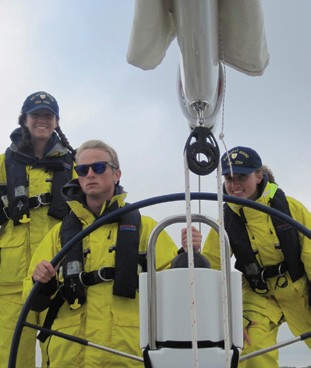 No day on a sailboat is the same as the last. Unlike an office job, every single day on a sailboat is special because of our exposure to the environment – and it’s the environment that is in charge. A heavier wind can overpower the boat, and we inevitably have days where it takes more work to keep the boat in balance. Various options exist for the cadets to reef our sails or ease the pressure, and we can find a new equilibrium that feels more manageable. In life and work, as with a heavy air day on the boat, sometimes we feel as if we are being blown over or overpowered.
No day on a sailboat is the same as the last. Unlike an office job, every single day on a sailboat is special because of our exposure to the environment – and it’s the environment that is in charge. A heavier wind can overpower the boat, and we inevitably have days where it takes more work to keep the boat in balance. Various options exist for the cadets to reef our sails or ease the pressure, and we can find a new equilibrium that feels more manageable. In life and work, as with a heavy air day on the boat, sometimes we feel as if we are being blown over or overpowered.
USCGA graduates (l – r) Alex Rennie, John Locke and Chelsea Sheehy, all from the class of 2014, are currently serving as U.S. Coast Guard officers. © LT Anderson Ogg
During those days, it might be best to “reef our sails” to minimize exposure and let some things blow by. We might not be able to catch everything that comes our way and still have an enjoyable journey. This realization leads to some very interesting reflections about trade-offs and balance. The cadet sailors are constantly experimenting with small adjustments with an awareness of all the forces inside and outside the boat; the cadets can make a small change – a little pull on the outhaul or an adjustment to the backstay, for example – and see a big result in performance. Like flattening or reefing the sails allows for a more comfortable ride, similarly there are little tweaks we can make to our life physically, emotionally, spiritually, and intellectually. On this trip, the cadets reflect on how, in the future, they will continue to face forces and pressures from various directions, and they decide which new habits or new routines, some of which might be small, that if tried, might make a big difference for an existence more in balance.
Getting anywhere requires a strong core and a homeport.
Throughout the trip, we face strong winds and currents, which inevitably, we don’t get to choose which direction they are blowing or flowing. Nevertheless, we adjust our sails and our techniques and we still make progress in our chosen route. Every single day we make it to a destination and we have always safely made it back to our homeport. We realize that every day we have overcome because we have had a strong keel deep under water. Our keel, the foundation and core of the boat, has kept us stable when everything above the water wanted to blow us over, wash us out, or push us in the wrong direction. Yet, with a strong keel, we’ve been able to arrange our rig so that we can get where we want, not where the environment would take us if we were weak.
On the last day of the trip we discuss what foundation the cadets are standing on; we examine what core is keeping them stable and steering straight. This can be a family or faith, but we all need something rooted deep if we are to overcome and ultimately make an impact. I ask the cadets if their “personal keel” needs attention, deepening or strengthening. During the trip, I like to wander around dry docks and see boats out of the water. I like to appreciate and admire what’s below the waterline. Ironically, as any Naval Architect can tell us, it’s about what’s under the water that keeps the boat afloat. Just like we might not have noticed our keel until we really needed it – when the wind wanted to blow us over or our boat got battered about by the waves, likewise, our character and values get tested under conditions of adversity, temptation and hardship. Our major realization is that boats with a strong keel and cadets with a strong core of character will prevail over whatever forces are against us.
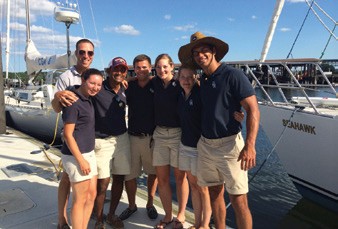 After the adventure, returning to homeport is always bittersweet. I return to my supportive wife and kids and the cadets get back to work. Both the boats and the crews get cleaned, rested, recharged, refueled and ready for the next one – whatever that means for each one of us. The beauty of sailing is that in our journey of only two weeks, we each come back forever changed. Cadet Jasen Kingsley said, “We don’t often realize it until after the summer, but in a way we really sense a difference about ourselves and our
After the adventure, returning to homeport is always bittersweet. I return to my supportive wife and kids and the cadets get back to work. Both the boats and the crews get cleaned, rested, recharged, refueled and ready for the next one – whatever that means for each one of us. The beauty of sailing is that in our journey of only two weeks, we each come back forever changed. Cadet Jasen Kingsley said, “We don’t often realize it until after the summer, but in a way we really sense a difference about ourselves and our
Second class cadets (l – r) LT Anderson Ogg, Jess Mulroy, Tharindu Wathuthanthri, Matt Chapman, Hayley Smith, Alyssa Milanese and Ricardo Rodriguez in port during a recent cruise. © LT Anderson Ogg
classmates.” That means to me that I’ve accomplished the mission. The cadets recognize that they have moved towards greater maturity with new insights, self-awareness, and friendships. With newfound courage and confidence they are ready to brave the next storm and continue on with more effective living in life, relationships and in our organization.
Lieutenant Commander Zeke Lyons is a company officer at the Coast Guard Academy where he teaches Organizational Behavior and Leadership. Originally from San Diego, he started sailing as an undergrad at San Diego State University. He has a Master’s in Organizational Psychology from Columbia Teacher’s College in New York City. His first sailboat was a 23-foot boat named Off-Duty Two, which he sailed on the Columbia River. He lives in Mystic, CT with his wife Abby and sons Levi and Saylor. He can be reached at zekelyons@hotmail.com.
*The views expressed herein are those of the author and are not to be construed as official or reflecting the views of the Commandant or of the U. S. Coast Guard.



